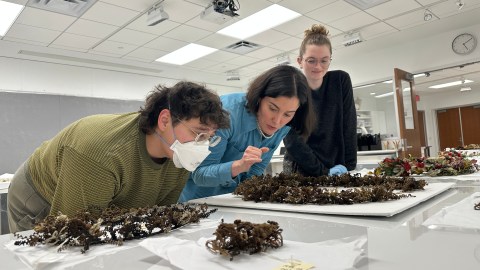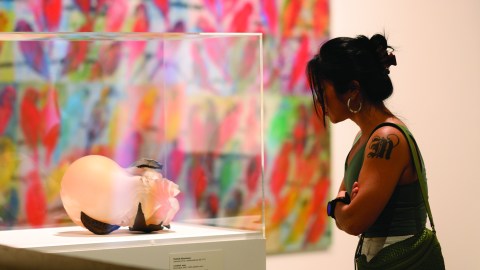Last July, Nicholas Negroponte, founder of the One Laptop Per Child project and co-founder of MIT Media Lab, keynoted at the WorldFuture 2013 conference. In the ten minute extract of his talk embedded below, he offers four ways of looking at potential futures: Extrapolative, Orthogonal, Metaphorical, and Contrarian. This is a useful framework for thinking about what futures fall within the Cone of Plausibility, and it spurred me to try to come up with museum examples for each category.
Extrapolative futures are ones we tend to assume will happen because our default habit of thought is that the future will be more or less like today (only more so). Negroponte lists as examples industries that assumed the world would be faithful to non-digital formats for photography, music, movies, books. The danger being, of course, that if we bet wrong (like Kodak doubling down on film-based pictures) someone else (like Instagram) is going to eat our lunch.
For museums, the equivalent might be:
Traditional, static, scholarly exhibits. Maybe embellished with a few apps and a accompanied by a digital exhibit catalog, but more or less more of the same. The good news, if true, because museums are already really, really good at creating this kind of experience. Which is fine, if the world continues to be faithful to this format, but what if the market shifts out from under us? Sure there are still fans dedicated to collecting and using large format cameras, but they support a niche market, not a mainstream economy of practice.
Orthogonal futures come at us from the side—they may be in our peripheral vision, but we underestimate the probability that they will move to front and center. As examples, Negroponte points to the rise of wireless communications, “non-ownership” (aka the sharing economy), Kickstarter (crowdfunding more generally) and Tinder. (I had to look that last one up. It’s an app that helps connect people for anonymous sex. I hope he’s wrong about that being part of a mainstream future.)
For museums, try:
The Museum as Participatory Experience. Some people are very resistant alternate futures, this one in particular. See, for example, the recent snarking about the Santa Cruz MAH under Nina Simon’s leadership. These critics conveniently overlook the fact that before its recent revitalization, that particular “traditional” museum was going broke. Which is a pretty good indication that in that local market, at least, the old business model was moribund, and the extrapolative future is becoming less and less probable. <
Metaphorical futures come about when people’s thinking is so shaped by a figure of speech, that language inspires us to create a new reality. Negroponte cites the way the analogy of physical “desktops” shaped our computer operating environments. For this one, I like
The Museum as Agora. We’ve heard for decades about the desire for museum to be a “place for dialog.” What if we actually managed to create a future in which museums were widely seen as the “center of athletic, artistic, spiritual and political life” of their cities? What would that look like? (Wait, notice where all those links track back to? Dang.)
Finally he comes to Contrarian futures—futures that are built in the face of popular opposition. Negroponte lists, for examples, nuclear power and genetically modified organisms (GMOs) as technologies he thinks are necessary and inevitable for successful human futures, however much some people may feel they are evil and dangerous. (Then he segues to a rant about iPhones and the Internet of Things that I don’t think belongs in this section, but you can bleep over that.) He lists education in his slide, but never gets to the commentary—I wish he had, because I wonder if he was going to mention MOOCs & internet-based education more generally, which some people are already slamming as either overblown, underperforming or both, while others hail it as the future of egalitarian, affordable learning. This is an absolute invitation to tick people off (otherwise it won’t be contrarian, right?) So I propose
The Digital Museum: where the majority of the benefit provided to society by museums is in the form of their digital assets—freely and widely shared as raw material including data, images, 3-D scans as well as “value-added” content such as online courses and virtual exhibits. Would physical museums cease to exist in this scenario? No more than windmills would be banished in Negroponte’s nuclear-fueled future—they just would be a minor player in the overall cultural scene.
Your turn. Feel free to build on or challenge my examples, or come up with your own, in the comments section below.








I stumbled across this and really enjoyed it. But why must it be that the only vision of the future that we get is the digital one where things become anachronistic windmills. STUFF that is a base line that makes it a museum. Hurrah for digital platforms but people like get live sniff touch carry cherish hate destroy stuff. Please use your smart brain to consider a future where how we use describe relate to stuff in new ways.
I try to come up with my own examples about the four ways of looking at potential futures (Extrapolative, Orthogonal, Metaphorical, and Contrarian ones) according to Nicholas Negroponte’ s theory.
Extrapolative futures: maybe newspapers vs web-sites.
Orthogonal futures: maybe web tv, that is to say watching tv on streaming through a web tv on a web site or through Fb pages and the differents videos loaded there.
Metaphorical futures: maybe an example of metaphorical future could be when someone creates his/her own avatar or another account with another artificial of fake identity.
Contrarian futures: for example the widespread of gluten free food or vegan or vegetarian one, with special restaurants where this kind of food is cooked or special shops where you can find and buy it.
Now I try to come up with my own examples strictly related to museums, always according to Negroponte’s theory about four ways of looking at potential futures: Extrapolative, Orthogonal, Metaphorical, and Contrarian ones.
Extrapolative futures: digitalization of works and artefacts.
Orthogonal futures : the introduction of Qr code.
Metaphorical futures: virtual and augmented reality.
Contrarian futures: the use of gamification.